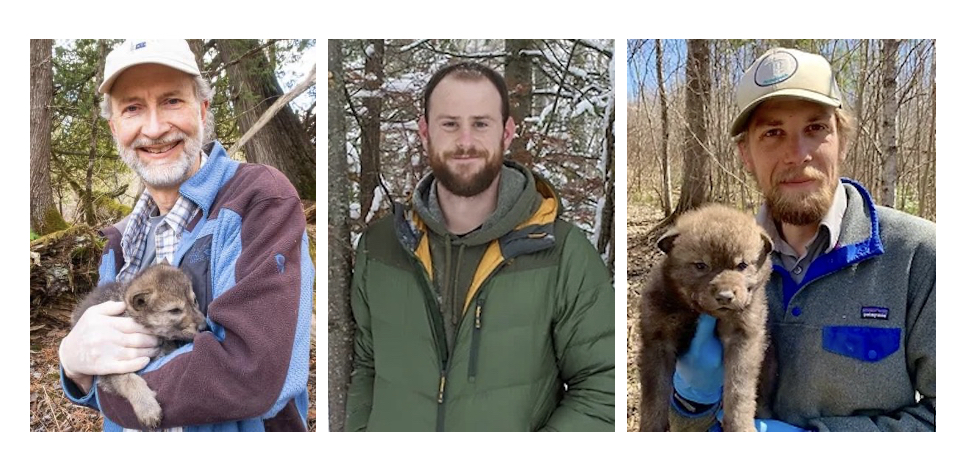As hunters throughout the Midwest gear up for the deer hunting season, new research from the Voyageurs Wolf Project in northern Minnesota—a collaborative team that includes a Northern Michigan University professor and two alumni—sheds light on how humans are having a profound impact on wolf-deer relationships by altering forest ecosystems.
“The premise is really quite simple: human activities change where deer are on the landscape, and wolves go where the deer are,” said Thomas Gable, who earned his master's from NMU in 2016 and is a postdoctoral researcher at the University of Minnesota and co-lead author of the study. “Plus, humans have done an excellent job of creating and maintaining a diverse, well-connected web of roads, trails, and other cleared linear features that are ideal corridors for wolves to hunt deer.”
The new study published in Ecological Applications found that every major way humans have altered the landscape of northern Minnesota—logging, road and trail creation, and infrastructure development—has fundamentally reshaped where wolves hunt and kill deer fawns.
Most logging in northern Minnesota involves clear-cutting forests. After forests have been cleared, dense stands of young saplings provide prime food for deer and provide excellent hiding spots for newborn fawns. However, wolves seem to know that these recently-logged areas are good hunting spots, turning these nursery grounds into risky areas for deer fawns during the summer.
“Our work indicates wolves disproportionately hunt and kill deer fawns around recently logged areas—those that have been logged within the past five years,” said Gable, “but not areas that have been logged more than five years ago. This is likely because clear-cut forests are much better deer habitat for the first few years after the area has been logged.”
However, it's not just logging that influences where wolves hunt and kill deer fawns. The research showed that wolves tend to kill deer fawns closer than expected to human infrastructure such as cabins, year-round residences and barns.
Because wolves are afraid of people, prey in some areas have learned to congregate around humans to avoid the predators. But it appears wolves are more willing to come into more human-dominated areas to hunt fawns. And the congregation of deer around people might have less to do with avoiding predators and more to do with getting food. Supplemental feeding of deer is common in the region, and this likely congregates deer near human-developed areas.
“Although the high concentration of deer near human development attracts wolves to areas near people, wolves still definitely avoid encountering people when hunting fawns around human infrastructure,” said Austin Homkes, a 2021 NMU master's graduate, field biologist for the Voyageurs Wolf Project and co-lead author of the study. “Wolves spend substantial time in close proximity to occupied cabins and residences, and yet almost no one sees them.”
In a related study, the researchers also found that roads, powerlines, ATV/UTV trails, and hunting lanes in rural areas often actually act as hunting highways for wolves. Wolves can travel faster and farther along these linear features compared to traveling in the dense forests of northern Minnesota. In turn, these features appear to increase wolf hunting efficiency by allowing wolves to cover a larger area more effectively while burning fewer calories.
“Wolves face the same general issues that people do when traveling in the woods, and just like humans, wolves often prefer to travel on linear corridors like roads and trails rather than bushwhacking through the dense forest,” said NMU Biology Professor John Bruggink, a co-author of the study.
So it came as no surprise to the research team that wolves preferentially hunted fawns from these linear features and disproportionately killed fawns closer to these features than would be expected.
“When we put all of the pieces together, it is pretty clear that the cumulative effects of all major aspects of human activity in the Northwoods have fundamentally changed where and how wolves hunt deer fawns here,” adds Sean Johnson-Bice, a PhD candidate from the University of Manitoba and co-lead author of the study. “The rules of this predator-prey game change when people alter ecosystems, and it's possible we have created conditions that may have tipped the scales in the predators' favor.”
The Voyageurs Wolf Project grew out of Bruggink's work with his former master's students Gable and Homkes. It is now managed by the University of Minnesota, with NMU as a continuing collaborator.
Gable and Homkes appeared in a Season 2 episode of National Geographic's “America's National Parks” focusing on the remote and lesser known Voyageurs. They were shown extracting wolf pups from a den, tagging them with a microchip and weighing them as part of the ongoing research.
In 2018, they were among researchers who documented a pack of wolves in Minnesota's Voyageurs National Park that hunted fish as a seasonal food source. This discovery, along with earlier studies, suggested the animals' diets are more varied than previously thought. Read more and watch a related video here.
Bruggink previously received a grant to support his involvement on the homesite ecology of gray wolves in the Greater Voyageurs Ecosystem as NMU's 2021 Peter White Scholar (read more here). The focus was on gaining a better understanding of habitat factors that influence where wolves choose to locate their homesites during pup-rearing season, and how those factors change as the pups develop and food availability varies.
Prepared by Voyageur's Wolf Project and NMU.


